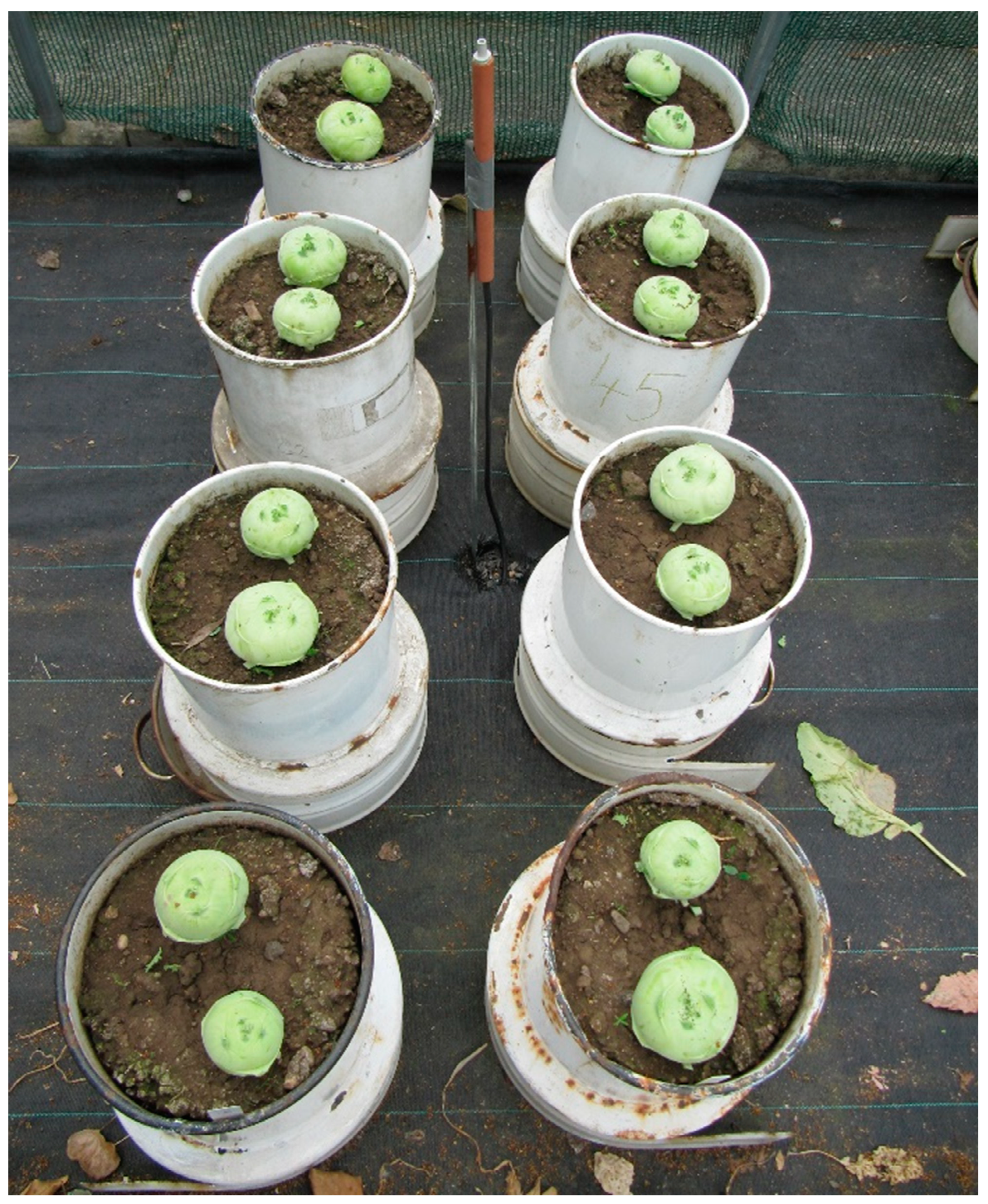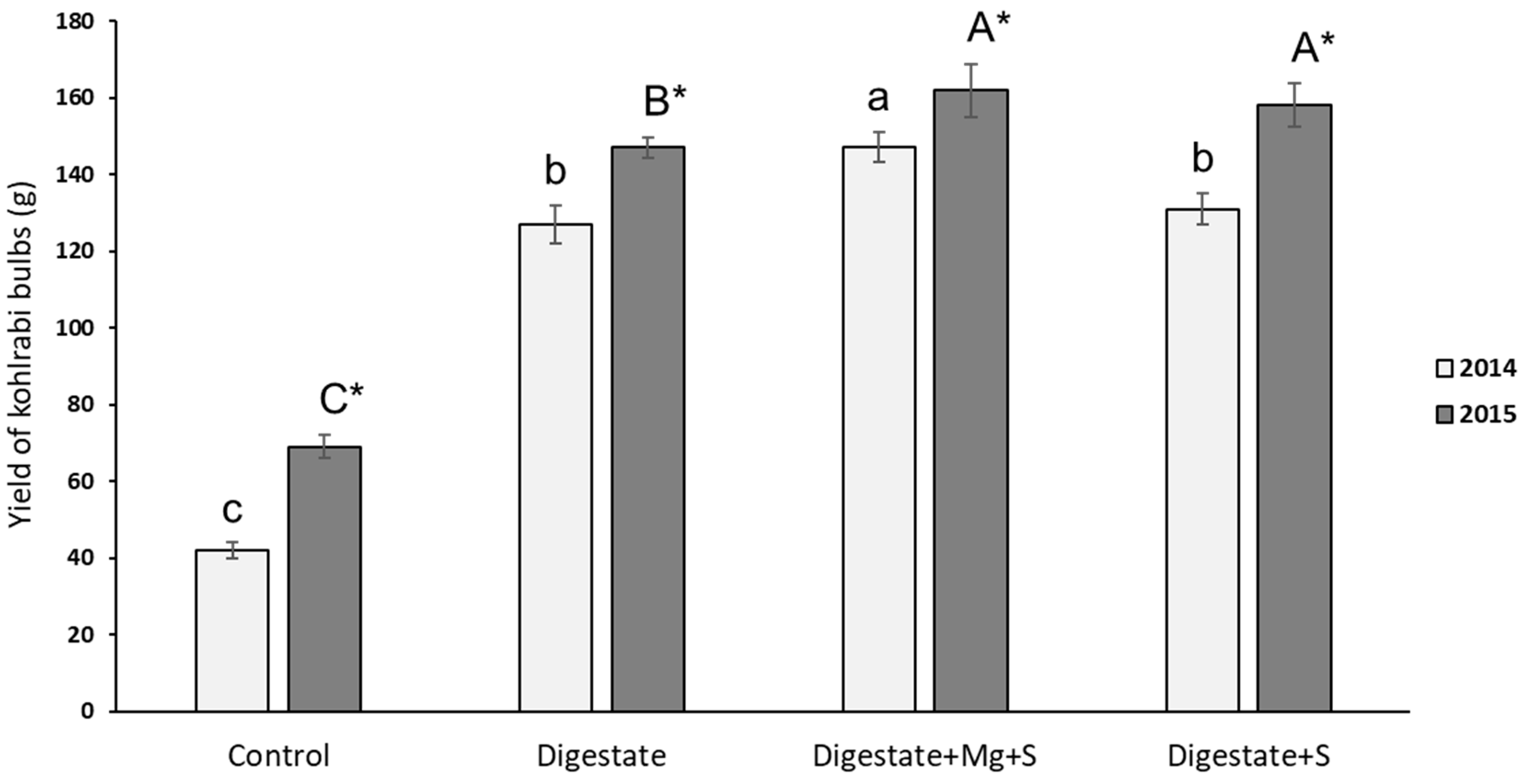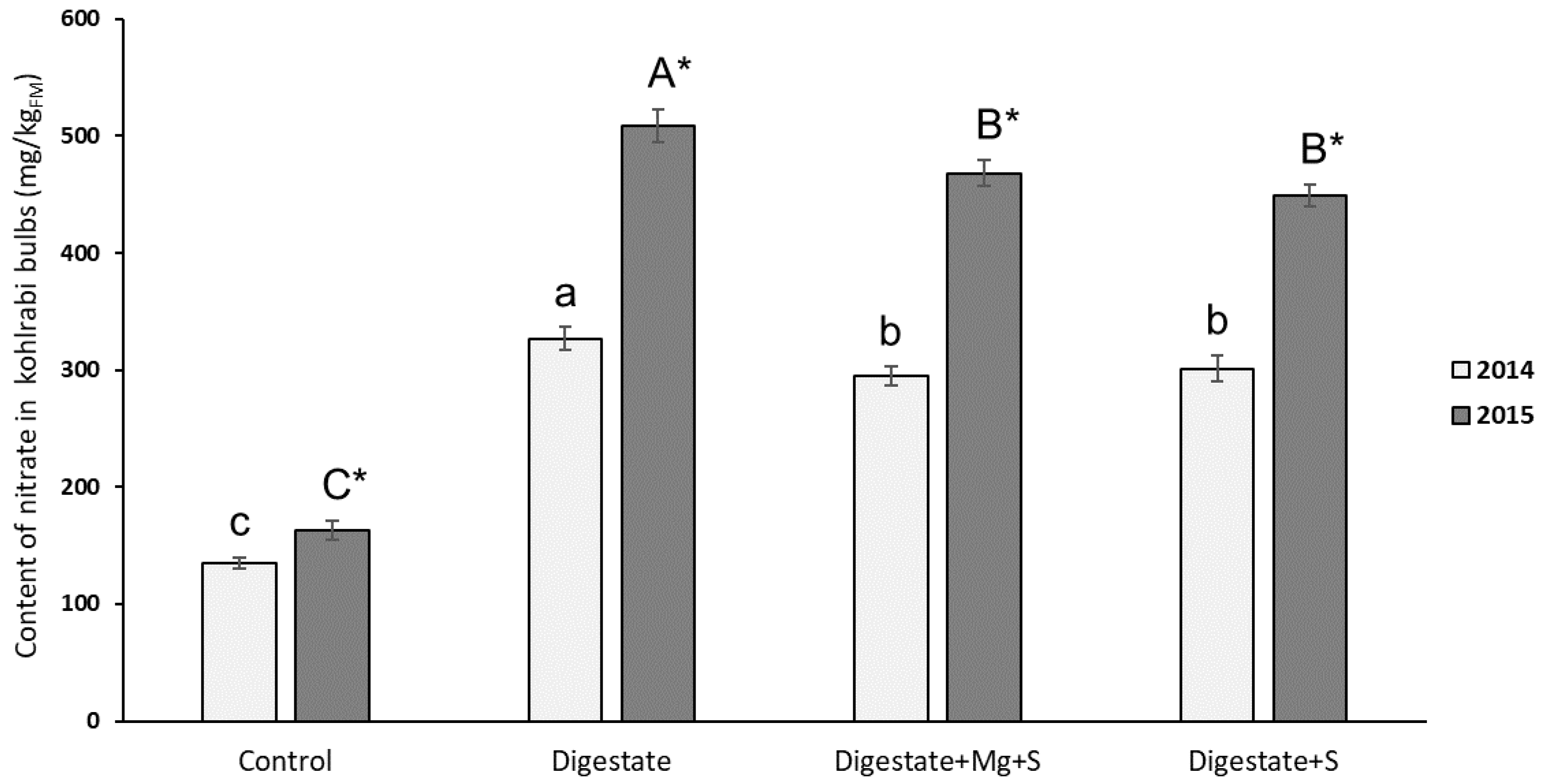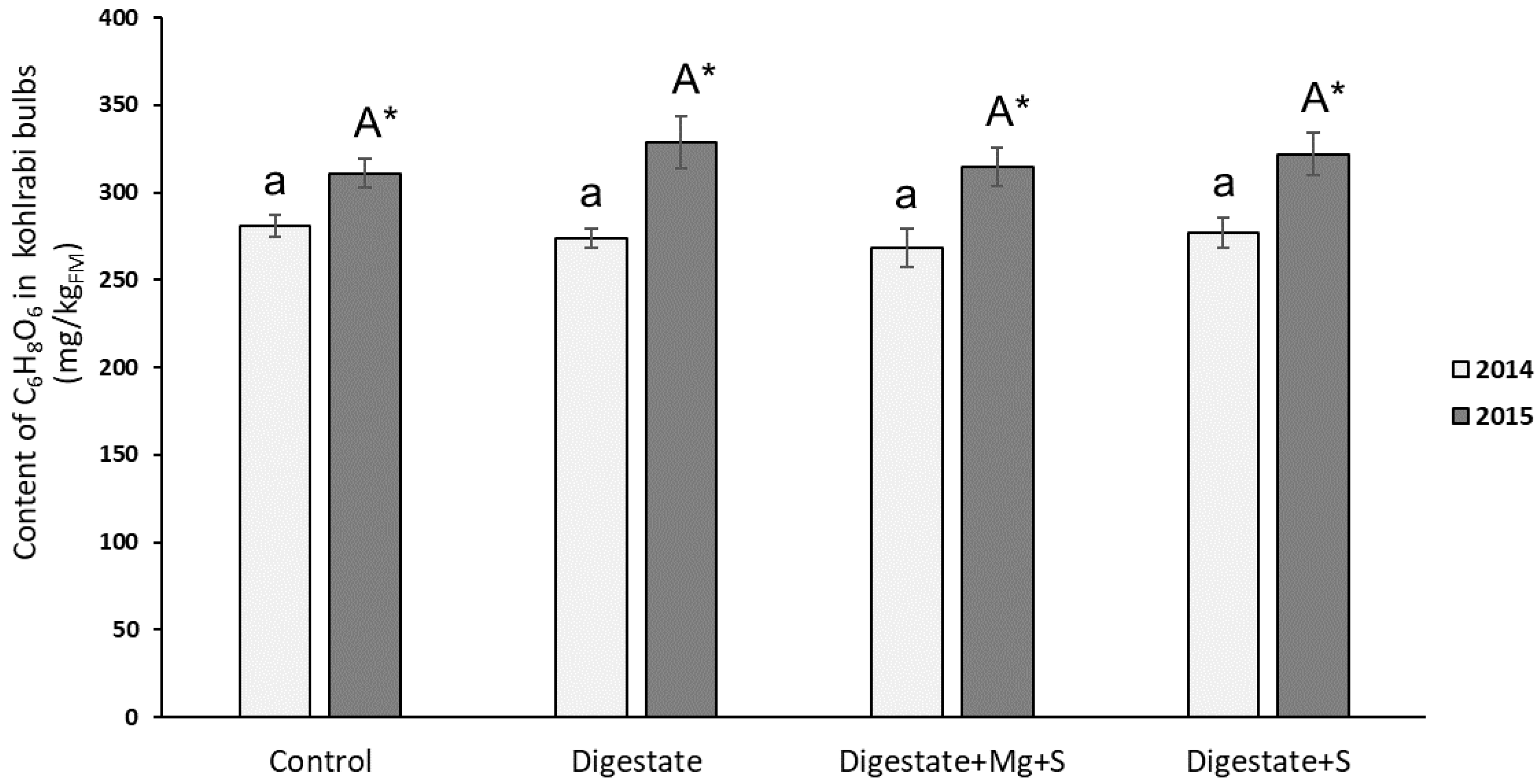Fertilization with Magnesium- and Sulfur-Supplemented Digestate Increases the Yield and Quality of Kohlrabi
Abstract
1. Introduction
2. Materials and Methods
2.1. Pot Experiment
2.2. Determination of Nitrates in the Bulbs
2.3. Determination of Ascorbic Acid in the Bulbs
2.4. Statistical Analysis
3. Results and Discussion
3.1. Weight of Single Bulbs
3.2. Content of Nitrates in the Bulbs
3.3. Content of Ascorbic Acid in the Bulbs
4. Conclusions
Author Contributions
Funding
Acknowledgments
Conflicts of Interest
References
- Browne, J.D.; Murphy, J.D. Assessment of the resource associated with biomethane from food waste. Appl. Energy 2013, 104, 170–177. [Google Scholar] [CrossRef]
- Siebielec, G.; Siebilec, S.; Lipski, D. Long-term impact of sewage sludge, digestate and mineral fertilizers on plant yield and soil biological activity. J. Clean. Prod. 2018, 187, 372–379. [Google Scholar] [CrossRef]
- Möller, K.; Müller, T. Effects of anaerobic digestion on digestate nutrient availability and crop growth: A review. Eng. Life Sci. 2012, 12, 242–257. [Google Scholar] [CrossRef]
- Lošák, T.; Hlušek, J.; Válka, T.; Elbl, J.; Vítěz, T.; Bělíková, H.; Bennewitz, E.A. The effect of fertilisation with digestate on kohlrabi yields and quality. Plant Soil Env. 2016, 62, 274–278. [Google Scholar] [CrossRef]
- Stinner, W.; Möller, K.; Leithold, G. Effects of biogas digestion of clover/grass-leys, cover crops and crop residues on nitrogen cycle and crop yield in organic stockless farming systems. Eur. J. Agron 2008, 29, 125–134. [Google Scholar] [CrossRef]
- Arthurson, V. Closing the global energy and nutrient cycles through application of biogas residue to agricultural land-potential benefits and drawbacks. Energies 2009, 2, 226–242. [Google Scholar] [CrossRef]
- Gunnarsson, A.; Bengtsson, F.; Caspersen, S. Use efficiency of nitrogen from biodigested plant material by ryegrass. J. Plant Nutr. Soil Sci. 2010, 173, 113–119. [Google Scholar] [CrossRef]
- Alburquerque, J.A.; Fuente, C.; Campoy, M.; Carrasco, L.; Nájera, I.; Baixauli, C.; Caravaca, F.; Roldán, A.; Cegarra, J.; Bernal, M.P. Agricultural use of digestate for horticultural crop production and improvement of soil properties. Eur. J. Agron. 2012, 43, 119–128. [Google Scholar] [CrossRef]
- Ross, D.J.; Tate, K.R.; Speir, T.W.; Stewart, D.J.; Hewitt, A.E. Influence of biogas-digester effluent on crop growth and soil biochemical properties under rotational cropping. N. Z. J. Crop Hortic. Sci. 1989, 17, 77–87. [Google Scholar] [CrossRef]
- Bath, B.; Elfstrand, S. Use of red clover-based green manure in leek cultivation. Biol. Agric. Hortic. 2008, 25, 269–286. [Google Scholar] [CrossRef]
- Przygocka-Cyna, K.; Grzebisz, W. Biogas digestate—Benefits and risks for soil fertility and crop quality—An evaluation of grain maize response. Open Chem. 2018, 16, 258–271. [Google Scholar] [CrossRef]
- Hlavinka, P.; Trnka, M.; Kersebaum, K.C.; Čermák, P.; Pohanková, E.; Orság, M.; Pokorný, E.; Fischer, M.; Brtnický, M.; Žalud, Z. Modelling of yields and soil nitrogen dynamics for crop rotations by HERMES under different climate and soil conditions in the Czech Republic. J. Agric. Sci. 2014, 152, 188–204. [Google Scholar] [CrossRef]
- Handlířová, M.; Lukas, V.; Smutný, V. Yield and soil coverage of catch crops and their impact on the yield of spring barley. Plant Soil Environ. 2017, 63, 195–200. [Google Scholar]
- Kren, J.; Klem, K.; Svobodová, I.; MíSa, P.; Lukas, V. Influence of sowing, nitrogen nutrition and weather conditions on stand structure and yield of spring barley. Cereal Res. Commun. 2015, 43, 326–335. [Google Scholar] [CrossRef]
- Odlare, M.; Pell, M.; Svensson, K. Changes in soil chemical and microbiological properties during 4 years of application of various organic residues. Waste Manag. 2008, 28, 1246–1253. [Google Scholar] [CrossRef] [PubMed]
- Kolář, L.; Kužel, S.; Peterka, J.; Štindl, P.; Plát, V. Agrochemical value of organic matter of fermenter wastes in biogas production. Plant. Soil Environ. 2008, 54, 321–328. [Google Scholar] [CrossRef]
- Möller, K.; Schulz, R.; Müller, T. Effects of setup of centralized biogas plants on crop acreage and balances of nutrients and soil humus. Nutr. Cycl. Agroecosyst. 2011, 89, 303–312. [Google Scholar] [CrossRef]
- Lošák, T.; Zatloukalová, A.; Szostková, M.; Hlušek, J.; Fryč, J.; Vítěz, T. Comparison of the effectiveness of digestate and mineral fertilisers on yields and quality of kohlrabi (Brassica oleracea L.). Acta Univ. Agric. Silvic. Mendel. Brun. 2011, 59, 117–122. [Google Scholar]
- Möller, K. Influence of different manuring systems with and without biogas digestion on soil organic matter and nitrogen inputs, flows and budget in organic cropping systems. Nutr. Cycl. Agroecosyst. 2009, 84, 179–202. [Google Scholar] [CrossRef]
- Thomsen, I.K.; Olesen, J.E.; Møllerb, H.B.; Sørensena, P.; Christensena, B.T. Carbon dynamics and retention in soil after anaerobic digestion of dairy cattle feed and faeces. Soil Biol. Biochem. 2013, 58, 82–87. [Google Scholar] [CrossRef]
- Šimon, T.; Kunzová, E.; Friedlová, M. The effect of digestate, cattle slurry and mineral fertilization on the winter wheat yield and soil quality parameters. Plant Soil Environ. 2015, 61, 522–527. [Google Scholar] [CrossRef]
- Mozafar, A. Plant Vitamins, 1st ed.; CRC Press: Boca Raton, FL, USA, 2017; p. 422. [Google Scholar]
- Zampelas, A.; Micha, R. Antioxidants in Health and Disease, 1st ed.; CRC Press: Boca Raton, FL, USA, 2016; p. 340. [Google Scholar]
- Koh, E.V.; Bissell, M.G.; Ito, R.K. Measurement of vitamin C by capillary electrophoresis in biological fluids and fruit beverages using a stereoisomer as an internal standard. J. Chromatogr. 1993, 633, 245–250. [Google Scholar] [CrossRef]
- Steingrobe, G.; Schenk, M.K. Influence of nitrate concentration at the root surface on yield and nitrate uptake of kohlrabi (Brassica oleracea gongyloides L.) and spinach (Spinacia oleracea L.). Plant Soil 1991, 135, 205–211. [Google Scholar] [CrossRef]
- Feller, C.; Fink, M. Nitrogen uptake of kohlrabi, estimated by growth stages and an empirical growth model. J. Plant Nutr. Soil Sci. 1997, 160, 589–594. [Google Scholar]
- Sharof, H.C.; Wier, U. Calculation of nitrogen immobilization and fixation. Gartenbau Hannover Germany. Bodenkunde 1994, 157, 11–16. [Google Scholar]
- Mengel, K.; Kirkby, E.A. Principles of Plant Nutrition, 5th ed.; Kluwer Academic Publishers: London, UK, 2001. [Google Scholar]
- Degryse, F.; Ajiboye, B.; Baird, R.; da Silva, R.C.; McLaughlin, M.J. Availability of fertiliser sulphate and elemental sulphur to canola in two consecutive crops. Plant Soil 2016, 398, 313–325. [Google Scholar] [CrossRef]
- Petříková, K.; Hlušek, J.; Jánský, J.; Koudela, M.; Lošák, T.; Malý, I.; Pokluda, R.; Poláčková, J.; Rod, J.; Ryant, P.; et al. Zelenina—Pěstování, Ochrana, Výživa, Ekonomika, 1st ed.; Profi Press: Prague, Czech Republic, 2012. [Google Scholar]
- Wang, Z.; Hassan, M.U.; Nadeem, F.; Wu, L.; Zhang, F.; Li, W. Magnesium Fertilization Improves Crop Yield in Most Production Systems: A Meta-Analysis. Front. Plant Sci. 2020, 10, 1727. [Google Scholar] [CrossRef] [PubMed]
- Marschner, H. Mineral Nutrition of Higher Plants, 3rd ed.; Academic Press: London, UK, 2012. [Google Scholar]
- Lošák, T.; Hlušek, J.; Kračmár, S.; Varga, L. The effect of nitrogen and sulphur fertilization on yield and quality of kohlrabi (Brassica oleracea L.). Rev. Bras. Cienc. Solo 2008, 32, 697–703. [Google Scholar]
- Czech, A.; Malik, A. Content of nitrates V and III and heavy metals in selected Brassica vegetables depending on storage. J. Elem. 2012, 17, 201–213. [Google Scholar]
- Schnug, E. Significance of sulphur for the quality of domesticated plants. In Sulphur Metabolism in Higher Plants: Molecular, Ecophysiological and Nutritional Aspects; Cram, W.J., De Kok, L.J., Brunold, C., Rennenberg, H., Eds.; Backhuys Publishers: Leiden, The Netherlands, 1997; pp. 109–130. [Google Scholar]
- Paulsen, H.M. Schwefel und Nahrungsqualität. In Schwefel-Informaionstag der FAL Braunschweig; Institute of Organic Farming: Braunschweig, Deutschland, 2001. [Google Scholar]
- Hlušek, J.; Richter, R.; Smatanová, M. Výživa a hnojení zelenin sírou. In Sborník z Konference Racionální Použití Průmyslových Hnojiv; ČZU: Prague, Czech Republic, 2001; pp. 56–61. [Google Scholar]
- Santamaria, P.; Elia, A.; Serio, F.; Gonnella, M.; Parente, A. Comparison between nitrate and ammonium nutrition fennel, celery and Swiss chard. J. Plant Nutr. 1999, 22, 1091–1106. [Google Scholar] [CrossRef]
- Prosser, I.M.; Purves, J.V.; Saker, L.R.; Clarkson, D.T. Rapid disruption of nitrogen metabolism and nitrate transport in spinach plants deprived of sulphate. J. Exp. Bot. 2001, 52, 113–121. [Google Scholar] [CrossRef]
- Kirchmann, H.; Witter, E. Composition of fresh, aerobic and anaerobic farm animal dungs. Bioresour. Technol. 1992, 40, 137–142. [Google Scholar] [CrossRef]
- Lee, S.K.; Kader, A.A. Preharvest and postharvest factors influencing vitamin C content of horticultural crops. Postharvest Biol. Technol. 2000, 20, 207–220. [Google Scholar] [CrossRef]
- Han, D.F.; Wang, D.H.; Huang, P.Z.; Duan, J.X.; Ge, R.S.; Zhou, W.L. Effects of different morphology magnesium on yield and quality of ‘Zaoshu 5′ Chinese cabbage. Acta Hort. Sin. 2010, 37, 1655–1660. [Google Scholar]
- Borowski, E.; Michalek, S. The effect of foliar nutrition of spinach (Spinacia oleracea L.) with magnesium salts and urea on gas exchange, leaf yield and quality. Acta Agrobot. 2010, 63, 77–85. [Google Scholar] [CrossRef]
- Albrecht, J.A.; Schafer, H.W.; Zottola, E.A. Relationship of total sulfur to initial and retained ascorbic acid in selected cruciferous and noncruciferous vegetables. J. Food Sci. 1990, 55, 181–183. [Google Scholar] [CrossRef]
- Mozafar, A. Nitrogen fertilizers and the amount of vitamins in plants: A review. J. Plant Nutr. 1993, 16, 2479–2506. [Google Scholar] [CrossRef]
- Smatanová, M.; Richter, R.; Hlušek, J. Spinach and pepper response to nitrogen and sulphur fertilization. Plant Soil Environ. 2004, 50, 303–308. [Google Scholar] [CrossRef]
- Nilson, T. The influence of soil type, nitrogen and irrigation on yield, quality and chemical composition of cauliflower. Swed. J. Agric. Res. 1980, 10, 65–75. [Google Scholar]
- Maurya, A.N.; Chaurasia, S.N.S.; Reddy, Y.R.M. Effect of nitrogen and molybdenum levels on growth, yield and quality of cauliflower (Brassica oleracea var. Botrytis) cv. Snowball-16. Haryana J. Hort. Sci. 1992, 21, 232–235. [Google Scholar]




| Treatment | Description | Rate of Nutrients (mg/pot): N-P-K-Mg-S | Fertilizer Used |
|---|---|---|---|
| 1 | Control | 0 | - |
| 2 | Digestate | 1,500-240-1,350-140-50 | digestate |
| 3 | Digestate + Mg + S | 1,500-240-1,350-280-240 | digestate, EPSO TOP * |
| 4 | Digestate + S | 1,500-240-1,350-140-240 | digestate, elementary S * |
| Treatment No. | Description | 2014 | 2015 |
|---|---|---|---|
| Rel. % | Rel. % | ||
| 1 | Control | 33.1 | 46.9 |
| 2 | Digestate | 100.0 | 100.0 |
| 3 | Digestate + Mg + S | 115.7 | 110.2 |
| 4 | Digestate + S | 103.1 | 107.4 |
| Treatment No. | Description | 2014 | 2015 |
|---|---|---|---|
| Rel. % | Rel. % | ||
| 1 | Control | 41.2 | 32.0 |
| 2 | Digestate | 100.0 | 100.0 |
| 3 | Digestate + Mg + S | 90.2 | 91.9 |
| 4 | Digestate + S | 92.0 | 88.2 |
| Treatment No. | Description | 2014 | 2015 |
|---|---|---|---|
| Rel. % | Rel. % | ||
| 1 | Control | 102.6 | 94.5 |
| 2 | Digestate | 100.0 | 100.0 |
| 3 | Digestate + Mg + S | 97.8 | 95.7 |
| 4 | Digestate + S | 101.1 | 97.8 |
© 2020 by the authors. Licensee MDPI, Basel, Switzerland. This article is an open access article distributed under the terms and conditions of the Creative Commons Attribution (CC BY) license (http://creativecommons.org/licenses/by/4.0/).
Share and Cite
Lošák, T.; Válka, T.; Elbl, J.; Kintl, A.; Keutgen, A.; Keutgen, N.; Demková, L.; Árvay, J.; Varga, L.; Hnátková, H.; et al. Fertilization with Magnesium- and Sulfur-Supplemented Digestate Increases the Yield and Quality of Kohlrabi. Sustainability 2020, 12, 5733. https://doi.org/10.3390/su12145733
Lošák T, Válka T, Elbl J, Kintl A, Keutgen A, Keutgen N, Demková L, Árvay J, Varga L, Hnátková H, et al. Fertilization with Magnesium- and Sulfur-Supplemented Digestate Increases the Yield and Quality of Kohlrabi. Sustainability. 2020; 12(14):5733. https://doi.org/10.3390/su12145733
Chicago/Turabian StyleLošák, Tomáš, Tomáš Válka, Jakub Elbl, Antonín Kintl, Anna Keutgen, Norbert Keutgen, Lenka Demková, Július Árvay, Ladislav Varga, Hana Hnátková, and et al. 2020. "Fertilization with Magnesium- and Sulfur-Supplemented Digestate Increases the Yield and Quality of Kohlrabi" Sustainability 12, no. 14: 5733. https://doi.org/10.3390/su12145733
APA StyleLošák, T., Válka, T., Elbl, J., Kintl, A., Keutgen, A., Keutgen, N., Demková, L., Árvay, J., Varga, L., Hnátková, H., Gondek, K., & Mierzwa-Hersztek, M. (2020). Fertilization with Magnesium- and Sulfur-Supplemented Digestate Increases the Yield and Quality of Kohlrabi. Sustainability, 12(14), 5733. https://doi.org/10.3390/su12145733







